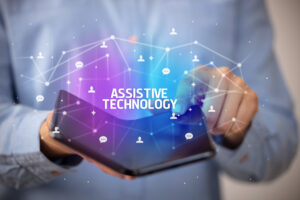
These are all examples from Microsoft demonstrating how technology can empower people with disabilities and make our world a more inclusive place. While new tech like AI, the cloud and mobile devices have created new possibilities for everyone who has access to them, these solutions can make a particularly significant difference when leveraged to help people who face challenges accessing key resources in educational and vocational settings, as well as other types of environments.
In recent years, new tools have emerged with the potential to break down barriers in our schools and workplaces. Many of these devices and programs fall into the category of assistive technology (AT), which includes systems, equipment and products that enhance daily life for people with disabilities, according to the Assistive Technology Industry Association (ATIA).
If you’re interested in promoting inclusivity within your organization, here’s some key information to consider about assistive technology products and the benefits of investing in these helpful tools.
What is assistive technology?
The ATIA defines assistive technology as “any item, piece of equipment, software program, or product system that is used to increase, maintain, or improve the functional capabilities of persons with disabilities.”
Assistive technology doesn’t just include cutting-edge software and devices. Various products fall under the umbrella of AT, ranging from low- to high-tech. Here are some examples from the ATIA, the National Institute of Child Health and Human Development (NICHD), and the World Health Organization (WHO):
- Wheelchairs
- Hearing aids
- Glasses
- Voice recognition programs
- Text-to-speech programs
- Screen readers and enlargers
- Specially designed computers, switches and keyboards
- Closed captioning for movies, TV shows and other media
- Devices designed to serve as cognitive aids and help with memory, attention and other thinking skills
As more advanced types of tech emerge (e.g., artificial intelligence), we also have new opportunities to develop novel assistive tech to make work and school settings more accommodating for everyone.
While news articles in recent years have highlighted how advanced consumer tech like self-driving cars benefits people living with disabilities, experts don’t necessarily agree that those tools qualify as assistive, according to a blog entry published by the Harvard Law School Petrie-Flom Center’s Bill of Health titled “New technologies are empowering persons with disabilities. But are they Assistive?”
The article offers analysis from Dr. Joseph Stramondo, a bioethicist and disability scholar who told Bill of Health that technology is assistive “if it identifies a user as disabled because of the meaning the technology holds in our shared cultural imagination.” As a result, in line with that reasoning, a motorized wheelchair would be considered assistive tech while autonomous vehicles would not, according to the blog entry.
The advantages of investing in assistive technology for people with disabilities
Overall, assistive products can help promote well-being and independence by enhancing a person’s ability to learn, work, play and otherwise lead healthy and productive lives, as the WHO explains. The examples from Microsoft at the beginning of this article are all great examples of how new IT solutions can make a positive difference – whether it’s through making a college biology class more accessible or allowing a data analyst to keep doing the work he loves.
Ultimately, while technology has transformative potential for everyone, access to tech is particularly vital for people who have disabilities. Without assistive tech, we’d miss out on valuable contributions from a significant portion of the population.
If you’re interested in learning more about assistive tech and how technology can help people with disabilities, please take a look at this list of resources from the American Association of People with Disabilities (AAPD).
You can also learn about Microsoft’s offerings and stories here: The power of technology for people with disabilities
For more information about emerging technology, feel free to reach out to our team of IT experts by calling 877-599-3999 or emailing sales@stratospherenetworks.com.


